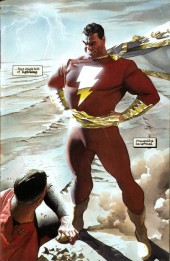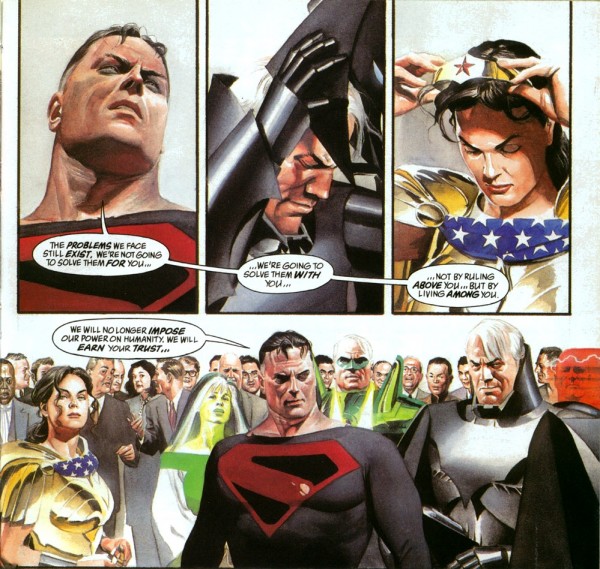 In comics, a miniseries is actually a pretty difficult thing to pull off well. Sure, there are plenty successful ones out there, but it takes a little something special to go from “good” to “great.” It takes even more to be Perfect.
In comics, a miniseries is actually a pretty difficult thing to pull off well. Sure, there are plenty successful ones out there, but it takes a little something special to go from “good” to “great.” It takes even more to be Perfect.
There are three ways to pull off a miniseries. First, you can go completely Original. This style is best seen in works like Kick Ass and just about everything worth mentioning from Frank Miller and Alan Moore. The Original Miniseries gives the creator free reign to do whatever their imagination (and artist) can come up with. However, none of these are the Perfect Miniseries. In an Original Miniseries, there is a limited amount of time to introduce your characters, set up the plot and reach a conclusion. It makes for a fun, fast-paced story that can be the start of something bigger, like Hellboy, but without the time and space for deeper development, these minis fall just short of Perfect. The one that comes closest is Watchmen, which I’ve previously selected as one of the five best comic stories ever. Unfortunately, at twelve issues, it’s hardly “mini.”
Next, we have the Continuity Miniseries. Minis like Crisis on Infinite Earths, Civil War or smaller, character-focused ones like the first Wolverine miniseries. Continuity Miniseries can cast aside some of the issues holding Original Miniseries back. We already know the characters, we’ve likely even seen the beginnings of the plot. Though, again, the Perfect Miniseries is not found here. The very thing helping with the development of a Continuity Miniseries is what holds it back from being Perfect. The stories just don’t stand apart on their own. Crisis could have easily been told as a Justice League story, Civil War as an Avengers story. They just don’t hold up well on their own. If you were to read one, with no knowledge of the events before or after, you would be left feeling incomplete. The character-based Continuity Miniseries stand up a little better here, but still require quite a bit of knowledge going in.
The final category is the Outside Miniseries. This type takes established characters or events and tells its own story with it. Sometimes within continuity, but usually taking place in an alternate reality, changing established details to create something new, or even telling a well-known story from an alternate point of view. Marvel Zombies twists reality by turning Marvel’s greatest heroes into… zombies. It’s right there in the title. Superman: Red Son asks the question, “What would happen is Superman landed in Russia instead of America?” Marvels re-tells many of Marvel’s most famous stories from the point-of-view of a normal human, a photographer. The thing that sets an Outside Miniseries apart is creative freedom. An Outside Miniseries can tell a story that would almost never occur in the pages of the regular monthly publications. Everybody knows Superman, most comic fans know the origins of the Marvel Universe. An great Outside Miniseries takes that basic knowledge and tells a completely unique story with it. That is why an Outside Miniseries has everything it takes to be the Perfect Miniseries. A simple, self-contained story with the space to fully develop. Of course, the ability to create an Outside Miniseries at their own pace, only publishing it when its ready, enables the writers and artists to put out some of their best work.
 So, what do I consider the Perfect Miniseries?
So, what do I consider the Perfect Miniseries?
Kingdom Come, published by DC in 1996. Written by Mark Waid, with art by Alex Ross
The first thing that sets Kingdom Come up as the Perfect Miniseries is the art. Alex Ross is the freaking man. He’s not a penciler, as is normal for comic artists. Ross is a painter. As such, each page takes longer to create, and he rarely does full art for a comic, usually sticking to covers or concept art. Kingdom Come is one of the rare occasions where he does all the art. Normally, I’m not a big fan of photorealistic art in comics, mostly because it never looks good, it just takes too much time to pull off. But, being an Outside Miniseries, DC gave Ross all the time he needed and the results are phenomenal. The art alone is only half the visual package, though. With Kingdom Come taking place in the future, Ross’s character designs are a comic nerd’s wet dream.
Great art is nothing without a good story, and Waid capably backs up Ross’ vision. Set decades in the future, Earth is a frightening place. Years prior, society had begun to favor a new generation of heroes, ones whose methods were more extreme than the Justice League. Disturbed by the change, Superman retired, with many of his allies following him into seclusion. Now, that new generation of “heroes” is threatening the civilians they’re supposed to protect. When a fight gets out of hand and Kansas is destroyed, Wonder Woman talks Superman into coming back.
With the old heroes coming back to set things right, conflicts with the new generation escalate. Those who don’t voluntarily join Superman’s side are forced into sharing his point of view. With no peaceful end in sight, humanity grows increasingly worried. Normal human beings, those without power, begin to wonder if Earth wouldn’t be better off without the entire superpowered community, with the familiar face of Bruce Wayne sharing the sentiment. Eventually, things reach critical mass and the United Nations decide to put an end to things with a single, decisive action.
While not a happy ending, exactly, Kingdom Come does end on a hopeful note. Published in the mid-90s, a time of excess in the comic industry, Kingdom Come can be seen as a cautionary tale of the future of some of DC’s competitors at the time, as they were moving in an increasingly mature direction. That, in addition to the artistic and story aspects is what makes Kingdom Come the Perfect Miniseries. It left behind a legacy. It would see a sequel several years later in The Kingdom. Additionally, Marvel commissioned Alex Ross to give their characters a similar treatment in the Earth X trilogy. Years later, the Kingdom Come story would be a large part of the monthly Justice society of America title. Magog, the leader of the “new generation,” would appear as part of the core DC Universe, even getting his own ongoing title.
The comic industry is full of copycats. Years later, writers are still trying to recreate Watchmen or The Dark Knight Returns. The only person who has been able to recreate the perfection of Kingdom Come is Alex Ross himself, nobody else has even tried. Instead, DC’s stable of creators are happy to simply build on it. The Perfect Miniseries not only stands on its own as a model of perfection, but inspires future generations to live up to its legacy.

